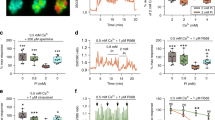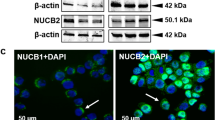Abstract
A calcitonin-responsive adenylate cyclase has been found in a cell line of a poorly differentiated bronchial carcinoma (BEN cells). The cells have previously been shown to secrete an immunoreactive form of calcitonin in culture. Salmon calcitonin (SCT), porcine calcitonin (PCT) and human calcitonin (CT-M) all stimulated adenylate cyclase activity in particulate preparations. CT-M sulphoxide had little effect. The concentrations of the calcitonins required for half the maximum activation of adenylate cyclase were 6-8, 18 and 90 nm respectively. SCT (30pm) and CT-M (60 pm) increased the intracellular concentration of cyclic AMP from 11-2+/-0-2 (s.e.) to 18-2+/-0-2 and 16-7+/-0-2 respectively over a 2-5-min period. SCT (labelled with 125I) bound to particulate preparations of Ben cells, and competition for binding occurred with unlabelled SCT and CT-M. The concentration of SCT required for half the maximum inhibition of [125I]SCT binding was 11 nm. CT-M sulphoxide inhibited only at high concentration (3 micron). The characteristics of the adenylate cyclase response to SCT did not change over the period between cell adhesion (after subculture) and confluence. However, pre-incubation of cells for 4 h with SCT (150 nm) abolished the subsequent adenylate cyclase response of particulate preparations to further hormone. The practical difficulties encountered in purifying and quantifying the large-mol.-wt. form of CT-M secreted by BEN cells has precluded direct investigation of the potential relationship between hormone secretion and the occurrence of the calcitonin receptor. This relationship is discussed in terms of its possible biological significance.
This is a preview of subscription content, access via your institution
Access options
Subscribe to this journal
Receive 24 print issues and online access
$259.00 per year
only $10.79 per issue
Buy this article
- Purchase on Springer Link
- Instant access to full article PDF
Prices may be subject to local taxes which are calculated during checkout
Similar content being viewed by others
Rights and permissions
About this article
Cite this article
Hunt, N., Ellison, M., Underwood, J. et al. Calcitonin-responsive adenylate cyclase in a calcitonin-producing human cancer cell line. Br J Cancer 35, 777–784 (1977). https://doi.org/10.1038/bjc.1977.119
Issue Date:
DOI: https://doi.org/10.1038/bjc.1977.119
This article is cited by
-
Calcitonin and its antinociceptive activity: Animal and human investigations 1975–1992
Agents and Actions (1994)
-
Localization and characterization of renal calcitonin receptors by in vitro autoradiography
Kidney International (1987)
-
Calcitonin gene-related peptide (CGRP) acts independently of calcitonin on cyclic AMP formation in clonal osteogenic sarcoma cells (UMR 106-01)
Calcified Tissue International (1986)
-
Adenylate cyclase of a human medullary thyroid carcinoma
Experientia (1981)



